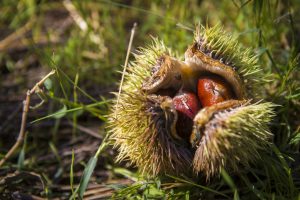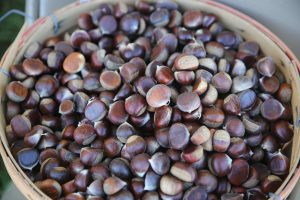When Ronald Revord joined the University of Missouri last year, he arrived with lofty goals in mind. Revord wasted no time in getting to work, either.
Revord spent his first three months on the job working on and submitting a grant proposal to the United States Department of Agriculture (USDA) focused on establishing a participant network to characterize genetic variety and ancestry of chestnuts in the Midwest. While Revord’s main goal was to complete the grant proposal and submit something he was happy with, his proposal was strong enough to earn him a grant for nearly $1 million. The grant comes from the USDA’s Agricultural Marketing Service Specialty Crop Multi-State Program.
“I had big goals coming in, and I’ve been very energetic from the start,” Revord said. “My goal with this grant really wasn’t even to receive any money. Success in my book was submitting the full proposal. I was using it as an exercise to refine my writing skills and get feedback from reviewers. To actually receive the grant was icing on the cake.”
Revord, an assistant research professor in the College of Agriculture, Food and Natural Resources’ (CAFNR) School of Natural Resources and faculty member for the Center for Agroforestry, joined MU in 2019 to lead the tree improvement and genetics program for Chinese chestnuts, pecan and black walnut, with new initiatives related to restoration of the Ozark chinquapin and hybrid hazelnut research.

The focus of the grant, which includes a collaboration with the University of Notre Dame, will look to formalize a participatory network of chestnut growers to characterize on-farm germplasm and assemble core sets of superior selections. Basically, Revord will work closely with chestnut growers to find the best performing and adapted seedling trees throughout respective areas in Missouri and the Midwest. It’s work that the Center for Agroforestry has already been participating in for more than a decade.
“I know this has been a dream project for the Center for quite some time,” Revord said. “Mike Gold [research professor in forestry] has been so key for the maintenance of grower relationships. Without those relationships, this in no way happens – and Mike was the guy making sure those relationships with growers were well maintained. There was a lot of long-term vision there.”
Revord said the first objective of his project is to figure out how to build on the existing partnerships.
“Growers need to be reassured that they are a priority and that they’re part of the project,” he said. “They will be giving us access to their materials and their process. They have to continue to be a part of the breeding and selection process, which includes setting the breeding objectives.
“The idea is to build a sustainable partnership so that breeding can continue through multiple breeding cycles and multiple generations of progeny. This grant will allow us to assemble the next generation of breeding parents. Theoretically, the next grant would be used to create the next generation of offspring with those breeding parents. That offspring wouldn’t just get evaluated here – it would be evaluated at the farms of participating growers, resulting in offspring selected within the growers’ respective environments. We already know that they’re adapted to those environments, so that makes a lot of sense.”
Revord said that chestnut growers have been at the forefront of the market’s growth. Grassroots chestnut production has led to multiple farmer cooperatives and regional markets in the Midwest. Those markets are showing more demand as well, meaning chestnut cultivation must increase to meet that demand. Revord said that from 2012 to 2017, the number of chestnut farms grew by 57 percent – including more than 400 new chestnut farmers in Midwestern and neighboring states.
“A lot of the growth of the chestnut market has been due to the efforts by growers to take the risks and try different things and be part of that learning curve,” Revord said. “They put a lot of sweat behind direct-to-consumer marketing.”
Chestnut orchards in the Midwest are primarily composed of half-sibling seedling families from open-pollinated traditional Chinese chestnut varieties. The seedling families have come from seeds grown at MU and purchased by the growers, but these chestnut cultivars are not native to Missouri.

“They might be transferable to our region in certain capacities, but not broadly adapted,” Revord said. “Right now, the region is really limited in being able to plant those cultivars, most of which are restricted to more southern climates.
“What growers have done in the past, facilitated by MU, is planted seedlings of cultivars we have. That’s especially true in northern regions where adaptability is more of a question mark. They’re searching for seedlings from particular families that can be cultivated with some reliability. It’s a work in progress and they’ve learned by doing for 20 years.”
Along with building on the existing partnerships, Revord will also look to develop a database of on-farm chestnut germplasm in the Midwest and characterize the variety, parentage and ancestry of the database selections with the help of Jeanne Romero-Severson, professor of quantitative genetics at the University of Notre Dame. Revord said they have plenty of data from growers, including information related to the seedling families that have transferred best across the various geographies.
“Building genetic improvement efforts from this pre-existing material capitalizes on decades of farmer investments and evaluations, offering an extraordinary opportunity to assemble the improved genetic base necessary to establish a dedicated breeding program,” Revord said.
“This grant is very unique. For chestnut growers, I think it’s been a long time coming. Some of these growers have been proposing some type of iteration of this work for more than a decade. This grant is a realization of that long-standing goal. It’s also a perfect partnership. We at MU offer an institutional home and systematic structure. However, we wouldn’t be able to evaluate this many mature plants across all of these different environments without the growers’ help. It’s just a perfect pairing.”
The Center for Agroforestry is one of CAFNR’s Programs of Distinction, a select collection of programs that exemplify CAFNR’s drive to distinction. Those programs define CAFNR’s current impact on Missouri’s agriculture and natural resource economies, providing understanding for how CAFNR is addressing challenges facing Missouri agriculture and natural resources.